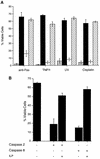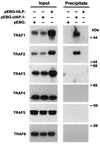Human IAP-like protein regulates programmed cell death downstream of Bcl-xL and cytochrome c
- PMID: 9418907
- PMCID: PMC121528
- DOI: 10.1128/MCB.18.1.608
Human IAP-like protein regulates programmed cell death downstream of Bcl-xL and cytochrome c
Abstract
The gene encoding human IAP-like protein (hILP) is one of several mammalian genes with sequence homology to the baculovirus inhibitor-of-apoptosis protein (iap) genes. Here we show that hILP can block apoptosis induced by a variety of extracellular stimuli, including UV light, chemotoxic drugs, and activation of the tumor necrosis factor and Fas receptors. hILP also protected against cell death induced by members of the caspase family, cysteine proteases which are thought to be the principal effectors of apoptosis. hILP and Bcl-xL were compared for their ability to affect several steps in the apoptotic pathway. Redistribution of cytochrome c from mitochondria, an early event in apoptosis, was not blocked by overexpression of hILP but was inhibited by Bcl-xL. In contrast, hILP, but not Bcl-xL, inhibited apoptosis induced by microinjection of cytochrome c. These data suggest that while Bcl-xL may control mitochondrial integrity, hILP can function downstream of mitochondrial events to inhibit apoptosis.
Figures

 ), pEBB-hILP (▪), pCI (□), or pCI-Bcl-xL (▨). Twenty-four hours after transfection, cells were treated with fresh medium or medium supplemented with either anti-Fas antibody and cycloheximide, rhTNF-α, or cisplatin or were exposed to UV. After 12 h, cells were fixed, stained for β-galactosidase expression, and scored for apoptotic morphology. (B) MCF7F cells were transfected with pCMV-lacZ together with pcDNA3, pcDNA3-caspase 2, or pcDNA3-caspase 8 with or without cotransfection of pEBB-hILP expression vector. At 24 h after transfection, cells were fixed, stained for β-galactosidase expression, and scored for apoptotic morphology. Results are expressed as percent viable cells (number of flat blue cells/number of flat and round blue cells × 100). The data represent means ± standard deviations (n = 3).
), pEBB-hILP (▪), pCI (□), or pCI-Bcl-xL (▨). Twenty-four hours after transfection, cells were treated with fresh medium or medium supplemented with either anti-Fas antibody and cycloheximide, rhTNF-α, or cisplatin or were exposed to UV. After 12 h, cells were fixed, stained for β-galactosidase expression, and scored for apoptotic morphology. (B) MCF7F cells were transfected with pCMV-lacZ together with pcDNA3, pcDNA3-caspase 2, or pcDNA3-caspase 8 with or without cotransfection of pEBB-hILP expression vector. At 24 h after transfection, cells were fixed, stained for β-galactosidase expression, and scored for apoptotic morphology. Results are expressed as percent viable cells (number of flat blue cells/number of flat and round blue cells × 100). The data represent means ± standard deviations (n = 3).





Similar articles
-
Cell-specific induction of apoptosis by microinjection of cytochrome c. Bcl-xL has activity independent of cytochrome c release.J Biol Chem. 1997 Nov 28;272(48):30299-305. doi: 10.1074/jbc.272.48.30299. J Biol Chem. 1997. PMID: 9374516
-
Curcumin (diferuloylmethane) induces apoptosis through activation of caspase-8, BID cleavage and cytochrome c release: its suppression by ectopic expression of Bcl-2 and Bcl-xl.Carcinogenesis. 2002 Jan;23(1):143-50. doi: 10.1093/carcin/23.1.143. Carcinogenesis. 2002. PMID: 11756235
-
Retroactive pathway involving mitochondria in electroloaded cytochrome c-induced apoptosis. Protective properties of Bcl-2 and Bcl-XL.Exp Cell Res. 2003 Oct 1;289(2):195-210. doi: 10.1016/s0014-4827(03)00255-6. Exp Cell Res. 2003. PMID: 14499621
-
Bid, a critical mediator for apoptosis induced by the activation of Fas/TNF-R1 death receptors in hepatocytes.J Mol Med (Berl). 2000;78(4):203-11. doi: 10.1007/s001090000099. J Mol Med (Berl). 2000. PMID: 10933582 Review.
-
Role of BCL-2 Family Proteins in Apoptosis and its Regulation by Nutrients.Curr Protein Pept Sci. 2020;21(8):799-806. doi: 10.2174/1389203721666191227122252. Curr Protein Pept Sci. 2020. PMID: 31880257 Review.
Cited by
-
Cancer and Apoptosis.Methods Mol Biol. 2022;2543:191-210. doi: 10.1007/978-1-0716-2553-8_16. Methods Mol Biol. 2022. PMID: 36087269
-
CCDC22 deficiency in humans blunts activation of proinflammatory NF-κB signaling.J Clin Invest. 2013 May;123(5):2244-56. doi: 10.1172/JCI66466. Epub 2013 Apr 8. J Clin Invest. 2013. PMID: 23563313 Free PMC article.
-
Expression of a murine homologue of the inhibitor of apoptosis protein is related to cell proliferation.Proc Natl Acad Sci U S A. 1999 Feb 16;96(4):1457-62. doi: 10.1073/pnas.96.4.1457. Proc Natl Acad Sci U S A. 1999. PMID: 9990045 Free PMC article.
-
Understanding Apoptosis and Apoptotic Pathways Targeted Cancer Therapeutics.Adv Pharm Bull. 2019 Jun;9(2):205-218. doi: 10.15171/apb.2019.024. Epub 2019 Jun 1. Adv Pharm Bull. 2019. PMID: 31380246 Free PMC article. Review.
-
Identification of ubiquitination sites on the X-linked inhibitor of apoptosis protein.Biochem J. 2003 Aug 1;373(Pt 3):965-71. doi: 10.1042/BJ20030583. Biochem J. 2003. PMID: 12747801 Free PMC article.
References
-
- Alnemri E S, Livingston D J, Nicholson D W, Salvesen G, Thornberry N A, Wong W W, Yuan J. Human ICE/CED-3 protease nomenclature. Cell. 1996;87:171. - PubMed
-
- Armstrong R, Aja T, Xiang J, Gaur S, Krebs J, Hoang K, Bai X, Korsmeyer S, Karanewsky D, Fritz L, Tomaselli K. Fas-induced activation of the cell death related protease CPP32 is inhibited by Bcl-2 and by ICE family protease inhibitors. J Biol Chem. 1996;271:16850–16855. - PubMed
-
- Armstrong, R. C. Unpublished observations.
-
- Bertin J, Armstrong R C, Ottilie S, Martin D A, Wang Y, Banks S, Wang G H, Senkevich T G, Alnemri E S, Moss B, Lenardo M J, Tomaselli K J, Cohen J I. Death effector domain-containing herpesvirus and poxvirus proteins inhibit both Fas- and TNFR1-induced apoptosis. Proc Natl Acad Sci USA. 1997;94:1172–1176. - PMC - PubMed
Publication types
MeSH terms
Substances
Grants and funding
LinkOut - more resources
Full Text Sources
Other Literature Sources
Research Materials
Miscellaneous
